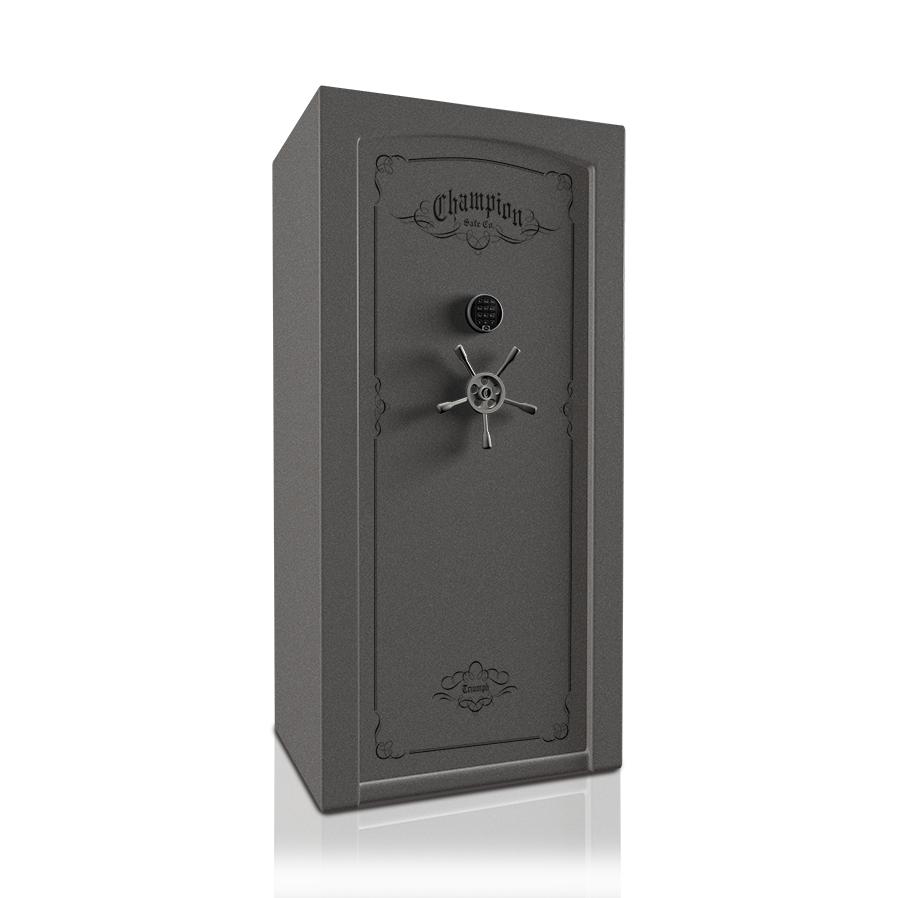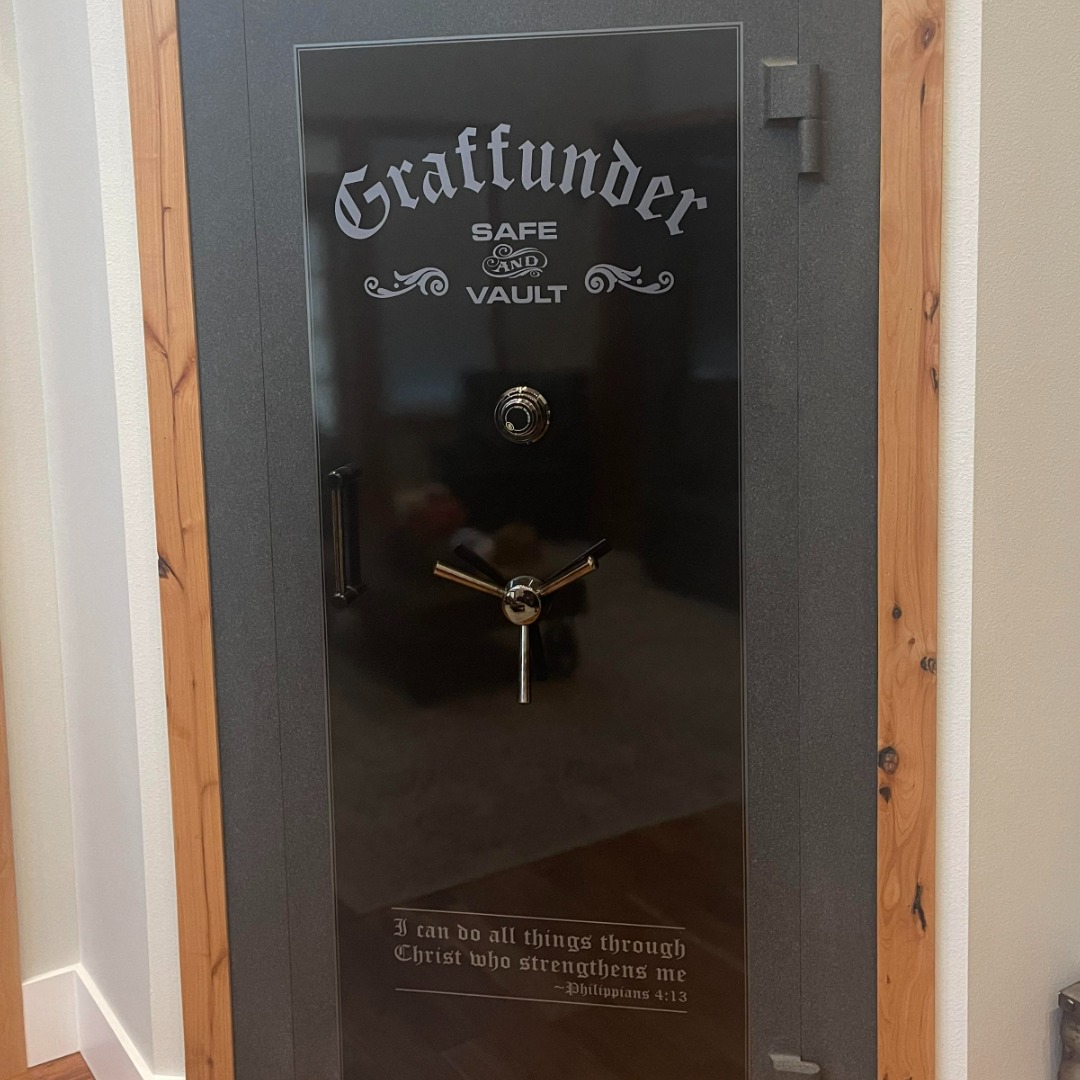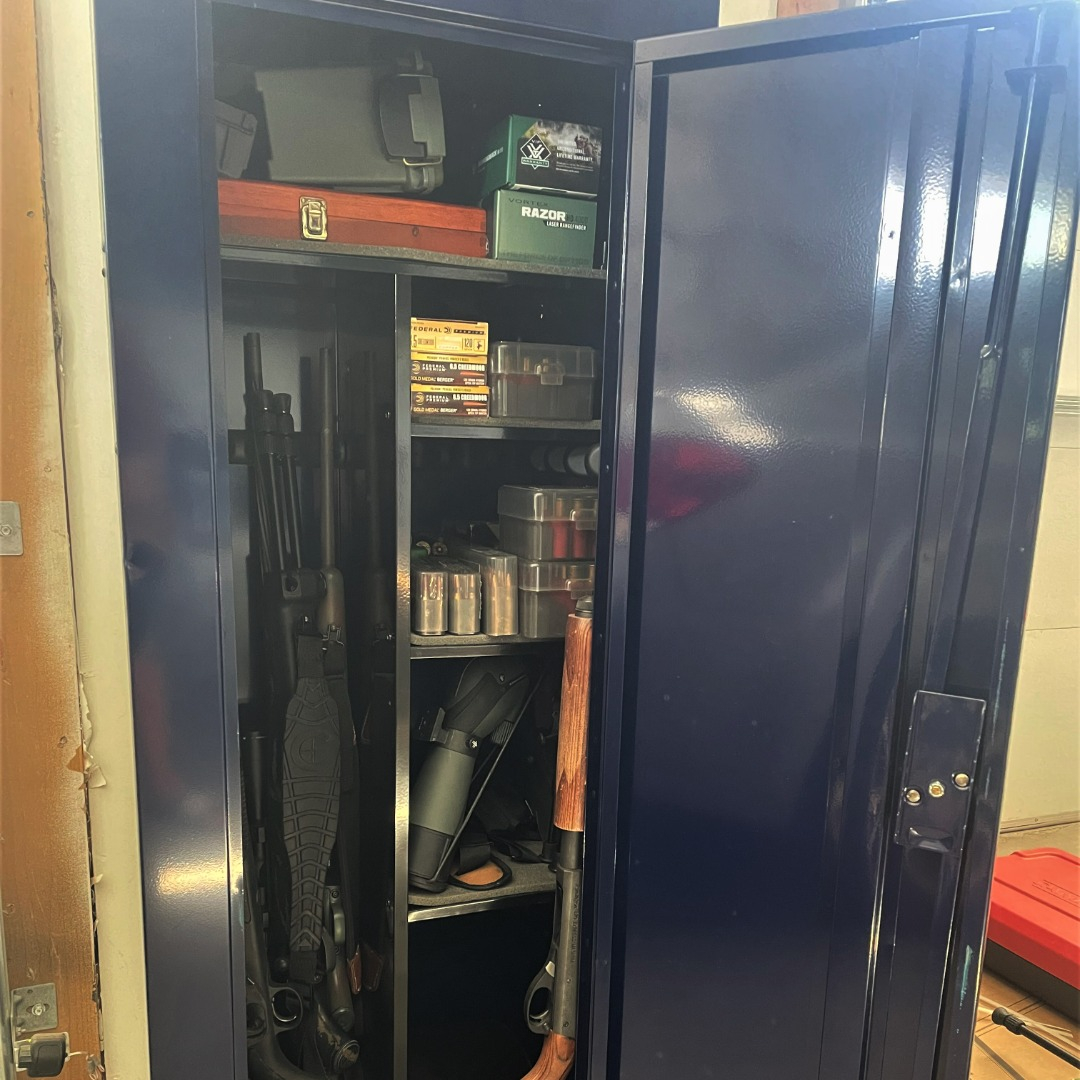
Responsible gun owners secure their firearms from unauthorized users. There’s really no two ways about it. Between kids and criminals, no household can escape the possibility of a break in, and gun owners owe it to their communities to do what they can to keep their firearms locked up.
But the sheer variety of gun safes and cabinets can be overwhelming. Safes feature a range of sizes, materials, and locking mechanisms, and can be had from $50 to $5,000. To help cut through all that noise, I asked the MeatEater crew about how they secure their rifles, shotguns, and handguns—and why they made the selections they did.
Jump to: The Safes We Use
What We Look for in a Gun Safe
Different safes are made for different purposes. Some are meant to be accessed quickly and can be secured under a bed or in a dresser drawer. Others are more properly called gun “cabinets” and feature thin metal walls and a key lock. Others are designed to house a person’s entire gun collection and can withstand fires, floods, and acts of God. Whatever safe you choose, there are several factors you should keep in mind:
- Security Features
- Locking Mechanism
- Price
- Size
Jump to: What Makes a Good Gun Safe
The Gun Safes We Use
This list is by no means exhaustive, but it does represent a broad swath of gun safes and cabinets available. If you’re looking for something between Kevin’s Champion and Spencer’s Stack-On, check out this Cannon 12-Gun safe, this Pro-Vault 18-Gun Safe from Liberty Safes, or these Agile Ultralight gun safes.
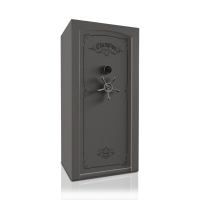 Champion Safe Triumph Series
Kevin's Pick
|
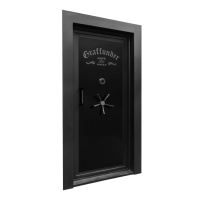 Graffunder Vault Door
Jason's Pick
|
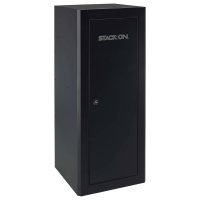 Stack-On Gun Cabinet Spencer's Pick
|
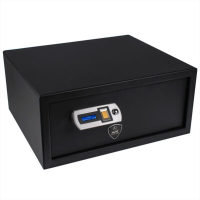 Zvetco Verifi S6000
Jordan's Pick
|
|
|---|---|---|---|---|
| Highlight | Most Fireproof | Most Secure | Best Value | Quick Access |
| Fire Rating | 90 minutes, 1,650 degrees | 1 hour, 1,750 degrees | None | None |
| Locking Mechanism | Electronic | Combination Lock | Key | Biometric Fingerprint |
| Size | 30 cu. ft., 36-rifle capacity | Custom | 12 cu. ft., 18-rifle capacity | 0.85 cu. ft., 2-handgun capacity |
| Price | $4,600* | $18,000* | $229* | $389* |
| Field Notes | Field Notes | Field Notes | Field Notes |
What Makes a Good Gun Safe
1. Security Features
This is the biggie, obviously. A gun safe that isn’t safe won’t do you much good. First, consider the thickness of the steel used in the safe’s construction. High-quality units use 10- to 12-gauge steel in the walls and a quarter-inch thick plate in the door. Also consider the type and configuration of the bolts used in the door. Even in gun cabinets that don’t use heavy-gauge metals, some units feature better security than others. This Stack-On gun cabinet, for example, uses welded z-tabs on the door to protect against pry attacks.
Second, be sure you can attach the safe to your floor. A well-prepared burglar will be more than happy to cart away your safe on a dolly and worry about breaking into it in the comfort of his home. This is especially important for quick-access handgun safes that can be picked up by hand.
Finally, try to find a safe that comes with at least a one-hour fire rating. Fire ratings for safes aren’t standardized, so look for a safe made in the U.S. from a reputable manufacturer.
2. Locking Mechanism
Different locking mechanisms come with inherent advantages and disadvantages. Electronic and biometric locks are more reliable than they were in previous decades, but there are still reasons you might want to go analogue.
Combination locks don’t need batteries or any other maintenance. It’s more difficult to observe the combination, and even if a sneaky kid figures it out, they still have to master the sequence (turn left, skip three times, turn right, skip twice, etc.).
However, combination locks are slow and inconvenient if you access them frequently, which is why electronic and biometric locks have become so popular. These locks require batteries, but they can be accessed almost instantaneously. It’s also easier to change the combination.
Older biometric locks faced reliability issues, but the one I own has never failed to open immediately (check out my “Field Notes” below for details).
3. Price
Dropping $800 or $1600 or $3,000 on a safe just to keep your guns secure can feel like a cruel joke, but if you want a heavy-duty safe that can withstand a house fire, there’s no way around it.
There are a few caveats to that generalization. First, if you only need to store four or six long guns, you can find a quality, fire-resistant safe for less. This Cannon 12-gun safe, for example, is a very reasonable $350.
Second, if you’re strapped for cash, remember that anything is better than nothing. If all you can afford is a gun cabinet with a key lock, that will often be enough to dissuade curious kids and opportunistic burglars. MeatEater’s Janis Putelis and Spencer Neuharth told me that they’ve always used gun cabinets to secure their firearms.
"They're in my price range and do what I need them to do: keep them locked away from my kids," Putelis told me. "If they burn up, I'll have to buy new guns. I'm not a collector of things, just experiences and memories."
4. Size
Because high-quality safes are so expensive, you don’t want to run out of room. It’s nearly impossible to fit as many rifles in a safe as most companies advertise because those estimates are for guns without scopes attached. You also may want to store other items (ammo, jewelry, important documents), so pick a safe that can accommodate your needs.
Don’t Forget About Humidity!
Firearms can last for generations, but not if rust gets to them first. Many gun owners mistakenly believe that their guns are safe from humidity in a fire-resistant gun safe, but I can tell you from personal experience, they aren’t. If you live in a humid environment, you want to make sure you install a dehumidifier to keep moisture from being trapped in your safe.
The most effective dehumidifiers are electronic and plug into an outlet on the inside of a safe. Since most safes aren’t large enough to house products that remove water from the air, rod-style dehumidifiers are the most popular. These units slightly increase the air temperature in your safe to continually circulate warm air and cut down on humidity and condensation.
If your safe doesn’t have an electrical outlet, I’ve found these renewable dehumidifiers to be incredibly effective. Not long after I purchased my rifle safe, I noticed that one of my new guns had developed surface rust on the barrel. I buffed out the rust, but I have yet to re-blue that spot of exposed steel because ever since I added these dehumidifiers in my safe, I haven’t seen a single spot of rust on any of my guns.
Field notes from the MeatEater Crew
Kevin Gillespie's Pick
Most Fireproof
When it comes to traditional, standalone gun safes, it doesn’t get much better than Champion’s Triumph Series. Available in sizes that can accommodate between 36 and 102 long guns, the Triumph Series’ 90-minute fire rating is the best on our list.
MeatEater’s Kevin Gillespie chose his Champion safe because it balances excellent protection with a high-value price.
"Choosing the right safe is never an easy task, but I’m a big fan of Champion Safes, and their Triumph series especially," he said. "These things come packed with features such as 90 minutes of fire protection, 10-gauge steel walls, built-in lights, and a dehumidifier. They’re also priced below many of the more common name brands."
A high-quality safe is a serious investment, but one of these Champion safes will last you a lifetime (and probably longer). If you’re looking for something less expensive than a used car, check out Champion’s Safe Guard Series.
Specifications
- Fire Rating: 90-minutes, 1,650 degrees
- Locking Mechanism: Electronic lock
- Size: 30 cu. ft., 36-rifle capacity
- Price: $4,600
Jason Phelps’ Pick
Most Secure
When Phelps Game Calls founder Jason Phelps drew up the plans for his new house, he knew he wanted to make room for a vault. He contacted Northwest Safe, and they recommended Graffunder because they offered the best security and would be able to customize the door to the room.
"Graffunder delivered with a beautiful and very heavy vault door with tolerances that were tight and perfect," Phelps explained. "They also use heavy steel intrusion bars with a rack and pinion gear system for locking, which is second to none in the safe world."
The vault door also has an internal locking mechanism, so the vault can double as a short-term safe room in an emergency.
Specifications
- Fire Rating: 1-hour 1,750 degrees
- Locking Mechanism: Combination lock
- Size: Custom
- Price: $18,000
Spencer Neuharth's Pick
Best Value
As you can see from Jason’s and Kevin’s picks, a large fire-resistant safe is going to cost you a pretty penny. Good-quality safes can be found in the $800 to $2000 range, but even a low-end unit can be out of reach for many gun owners.
If that’s you, that’s OK. Gun cabinets can’t withstand a house fire or power-drill-wielding burglar, but they’re a hell of a lot better than keeping your guns in the back of the closet. MeatEater’s Spencer Neuharth likes his Stack-On Gun Cabinet because while it may not survive a fire or a flood, "it will keep out dust, lazy criminals, and children."
"Is this thing fancy? Nope. But does it keep my guns and ammo in a safe, tidy place. If you want an economical upgrade over keeping firearms in the closet, this is it," he said.
Don’t let sticker shock keep you from securing your firearms. If you can’t afford a gun safe now, pick up one of these gun cabinets.
Specifications
- Fire Rating: None
- Locking Mechanism: Key
- Size: 12 cu. ft., 18-rifle capacity
- Price: $229
Jordan Sillars’ Pick
Quick Access
The Zvetco Verifi S6000 Smart Safe is a steel lock box with a high-quality biometric locking mechanism. It isn’t fire-resistant, but I don’t need it to be. It can be bolted to the floor to dissuade burglars, and I only keep a single handgun inside. If a fire melts it into a pile of plastic and steel, so be it.
The biometric locking mechanism has never failed to work instantaneously in the six years I’ve had it. It uses a capacitance fingerprint sensor (rather than an optical sensor), which takes a 3-D image of the sub-dermal layer of the skin. This means that even if your finger is dirty or wet, the safe will still open.
The electronic mechanism can be programmed to recognize multiple fingerprints, so both I and my wife can open it with all five fingers. It keeps a record of unauthorized open attempts, and it beeps whenever it needs new batteries (I’ve only had to change them once).
Some folks don’t secure their firearms because they worry about being able to quickly access a home-defense weapon. If that’s you, check out the Zvetco. You can keep this safe under your bed for emergencies and securely store your hunting rifles and shotguns in a larger safe. With today’s quick-access technology, there really isn’t a reason not to keep your guns secure.
Specifications
- Fire Rating: None
- Locking Mechanism: Biometric Fingerprint
- Size: 0.85 cu. ft., 2 handguns
- Price: $389.99

